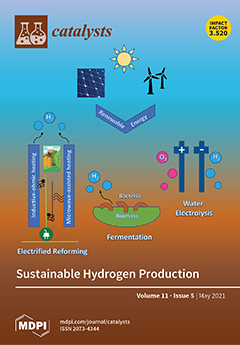Chromium oxide supported on mesoporous organo-silica (MOS) was synthesized with different Cr loading by an incipient method. The catalytic performance of a Cr(x)/MOS catalyst for CO
2-based ethane dehydrogenation was investigated. The synthesized catalysts were characterized by XRD, BET, TEM, SEM, XPS,
[...] Read more.
Chromium oxide supported on mesoporous organo-silica (MOS) was synthesized with different Cr loading by an incipient method. The catalytic performance of a Cr(x)/MOS catalyst for CO
2-based ethane dehydrogenation was investigated. The synthesized catalysts were characterized by XRD, BET, TEM, SEM, XPS, FTIR, and UV–Vis DR measurements. The textural properties of the prepared samples showed that the mesoporous nature of MOS sample was not disturbed by chromium impregnation. Among the prepared samples, Cr(8)/MOS catalyst exhibited good distribution of chromium species along with superior concentration of Cr
6+ and the highest recorded Cr
6+/Cr
3+ ratio. The results revealed that the superior catalytic performance was reached at Cr(8)/MOS, with 50.4% and 90.1% of ethane conversion and ethylene selectivity, respectively. The catalytic activity decreased slowly over reaction time; it declined approximately 22% after 10 h of stream operation. The roles of CO
2-based ethane dehydrogenation were also studied, where carbon dioxide can be a source of lattice oxygen and as a hydrogen consumer in reverse water–gas shift (RWGS) reaction. The effect of various catalytic factors, such as catalytic temperature, reaction time, space gas velocity, and CO
2 partial pressure on the conversion of ethane, yield, and selectivity to ethylene, were investigated as well.
Full article





